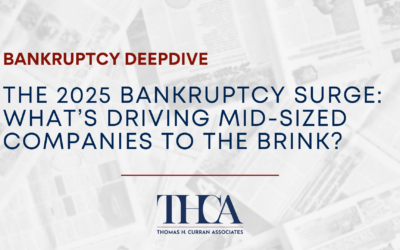Business Bankruptcy Attorney
Business organizations faced with extreme financial and operational difficulties have two options available in bankruptcy: reorganization under Chapter 11 or liquidation under Chapter 7.
Chapter 7 vs. Chapter 11. Under Chapter 7, a business debtor’s assets become property of the bankruptcy estate and are turned over to a bankruptcy trustee who will administer and liquidate the assets then distribute any proceeds to creditors after paying the administrative expenses of the bankruptcy estate. Alternatively, Chapter 11 bankruptcy provides otherwise viable businesses experiencing financial or operational difficulties with the opportunity to continue operations while negotiating a plan to restructure their debt and reorganize the company to bring it back to profitability. The restructuring is accomplished through a Chapter 11 reorganization plan that, once confirmed by at least one class of creditors and the Bankruptcy Court, outlines a new contractual relationship between the debtor and its creditors. The decision to file a bankruptcy reorganization or liquidation requires sophisticated counsel capable of providing advice on myriad legal, financial and other issues. Thomas H. Curran Associates’s business bankruptcy attorneys work along side other professionals such as accountants, appraisers, brokers, financial advisors and others involved in the bankruptcy process to provide clients with the information and advice a client needs when entering the bankruptcy process.
A Chapter 7 or 11 case begins when the debtor files a petition with the Bankruptcy Court. After the filing of the petition, the debtor is protected by an automatic stay that stops all collection attempts and lawsuits that are proceeding against the debtor. When a Chapter 7 case is filed, a trustee is immediately appointed, while under Chapter 11, the debtor usually assumes the role of the debtor in possession in lieu of a trustee throughout the proceedings. However, in some scenarios, the Bankruptcy Court may appoint a trustee to manage the bankruptcy estate.
In a Chapter 11 case, the debtor in possession draws up and files a plan of reorganization with the court that lays out the proposed substantive rights of the debtor and creditors. The plan may restructure the business in several different ways, including securing more favorable loan financing, giving lenders priority on earnings, or by rejecting and canceling executory contracts like property and equipment leases. If the business is insolvent, the restructuring may leave the debtor without assets and its creditors owning the reorganized company.
The Bankruptcy Code requires that the plan be accompanied by a disclosure statement providing additional information to the creditors that allow them to make informed decisions regarding the debtor’s plan. The disclosure statement can include such items as a history of the debtor’s business operations, projections regarding the debtor’s ability to make payments under the plan, and a liquidation analysis.
Once a Chapter 11 plan has been agreed upon by the corporation, partnership, or LLC’s creditors and confirmed by the Bankruptcy Court, it is up to the business to fulfill its terms. If the business meets its obligations under the plan it will have successfully discharged its obligations. Businesses that fail to comply with the provisions of the confirmed plan face the possibility of having their Chapter 11 case dismissed or converted into a Chapter 7 liquidation if they are unable to negotiate an amended plan.
Small Business Reorganizations. While Chapter 11 bankruptcy was traditionally considered too burdensome and expensive for small businesses to utilize, some recent changes to the U.S. Bankruptcy Code have made it easier for them to take advantage of the provision. The Small Business Reorganization (SBR) Act of 2019 added Subchapter V to Chapter 11 to simplify the proceedings for businesses with less than $2,725,625 in debt. The Coronavirus Aid, Relief, and Economic Security (CARES) Act was signed into law March 28, 2020, and temporarily raised the maximum debt for a Subchapter V bankruptcy to $7.5 million for one year.
The key benefits of Subchapter V bankruptcy include:
- Continued Ownership and Management. So long as unsecured creditors are paid using the debtor’s disposable income for a period of three to five years under a reorganization plan, equity holders will continue to own and manage the business. Disposable income is defined as income that is not needed to pay the expenses necessary to continue the debtor’s business operations.
- 90 Days to File a Plan. Debtors must file a plan no later than 90 days after entering bankruptcy unless a judge orders otherwise. Additionally, only the debtor may file a plan for reorganization.
- No Disclosure Statement. The disclosure statement that must be filed by most Chapter 11 debtors is not required in a Subchapter V bankruptcy unless ordered by the court for cause. A Chapter 11 disclosure statement usually includes such things as a brief history of the debtor’s business operations, a liquidation analysis, and projections regarding the debtor’s ability to make payments under the plan.
- No Creditors’ Committee. Under Subchapter V, no committee of creditors will be appointed unless ordered by the Bankruptcy Court.
- No Creditor Approval Needed. A reorganization plan can be confirmed without the vote of an impaired accepting class so long as the plan is deemed fair and equitable to each class of claims and does not discriminate unfairly.
- Delayed Payment of Administrative Expenses. In a traditional Chapter 11 case, administrative expense claims must be paid on the effective date of the reorganization plan, but a Subchapter V debtor may stretch those payments over the term of the plan.
- Specialized Trustee Appointed. The debtor continues to manage the business, but one or more Subchapter V trustees will be appointed to monitor the debtor’s affairs, evaluate the debtor’s assets, assess the debtor’s prospect for success, and offer recommendations regarding the confirmation of the debtor’s plan.
The business bankruptcy attorneys of Thomas H. Curran Associates are experienced in assisting business clients operating in various business sectors in successfully navigating Chapter 7 or Chapter 11. Business principals faced with the challenges of today’s business environment should consult Thomas H. Curran Associates business bankruptcy lawyers early on to ensure the best outcome for all stakeholders in the bankruptcy process.
Bankruptcy Practice Results
Recent successful cases handled by the attorneys from Thomas H. Curran Associates. Find more here »
Supreme Court Denies Final Appeal, Finalizing Judgement Obtained by THCA
On June 24, 2024, the Supreme Court of the United States declined the petition to review filed by Sean Dunne and his ex-wife Gayle...
Thomas H. Curran Associates Secures Appellate Victory as Massachusetts Supreme Judicial Court Denies Appellant’s Attempt to Shortcut Ordinary Appellate Review
Thomas H. Curran Associates recently obtained an appellate victory in the Massachusetts Supreme Judicial Court on May 26, 2023, in the...
Thomas H. Curran Associates win is Affirmed in Florida, U.S. District Court – Client Wins Attorneys Fees
Law: Federal Rule of Civil Procedure 37(a)(5) Case: Premier Capital, LLC v. Larry Bryan (AP) Underlying Bankruptcy Case: In re Larry Bryan...
The Second Circuit Affirms Bankruptcy Fraud Judgment Obtained by Thomas H. Curran Associates, Recognizing the Continuous Concealment Doctrine
Law: Continuous concealment doctrine, 11 USC § 727(a)(2)(A), In re Olivier, 819 F.2d 550 (5th Cir. 1987); In re Boyer, 328 F. App’x 711,...
Thomas H. Curran Associates prevails on barring discharge due to fraud by debtor
Thomas H. Curran Associates recently secured a victory on behalf of an institutional asset manager, where the Bankruptcy Court for the...
Thomas H. Curran Associates prevails on post-trial motions and obtains full security for $23 million dollar financial fraud judgment on behalf of chapter 7 bankruptcy trustee
On February 8, 2022, the United States District Court for the District of Connecticut (Meyer, J.) enter its Order denying defendant Gayle...
Supreme Court Denies Final Appeal, Finalizing Judgement Obtained by THCA
On June 24, 2024, the Supreme Court of the United States declined the petition to review filed by Sean Dunne and his ex-wife Gayle...
Thomas H. Curran Associates Secures Appellate Victory as Massachusetts Supreme Judicial Court Denies Appellant’s Attempt to Shortcut Ordinary Appellate Review
Thomas H. Curran Associates recently obtained an appellate victory in the Massachusetts Supreme Judicial Court on May 26, 2023, in the...
Thomas H. Curran Associates win is Affirmed in Florida, U.S. District Court – Client Wins Attorneys Fees
Law: Federal Rule of Civil Procedure 37(a)(5) Case: Premier Capital, LLC v. Larry Bryan (AP) Underlying Bankruptcy Case: In re Larry Bryan...
The Second Circuit Affirms Bankruptcy Fraud Judgment Obtained by Thomas H. Curran Associates, Recognizing the Continuous Concealment Doctrine
Law: Continuous concealment doctrine, 11 USC § 727(a)(2)(A), In re Olivier, 819 F.2d 550 (5th Cir. 1987); In re Boyer, 328 F. App’x 711,...
Supreme Court Denies Final Appeal, Finalizing Judgement Obtained by THCA
On June 24, 2024, the Supreme Court of the United States declined the petition to review filed by Sean Dunne and his ex-wife Gayle...
Thomas H. Curran Associates Secures Appellate Victory as Massachusetts Supreme Judicial Court Denies Appellant’s Attempt to Shortcut Ordinary Appellate Review
Thomas H. Curran Associates recently obtained an appellate victory in the Massachusetts Supreme Judicial Court on May 26, 2023, in the...
Thomas H. Curran Associates win is Affirmed in Florida, U.S. District Court – Client Wins Attorneys Fees
Law: Federal Rule of Civil Procedure 37(a)(5) Case: Premier Capital, LLC v. Larry Bryan (AP) Underlying Bankruptcy Case: In re Larry Bryan...
Bankruptcy Areas of Expertise
- Bankruptcy Litigation
- Bankruptcy Trustee Representation
- Avoidance & Recovery Actions
- Chapter 11 Trustees & Examiners
- Discharge Litigation
- Bankruptcy Fraud Investigations
- Cross Border Foreign Litigation
- 363 Bankruptcy Sales
- Bankruptcy Preference Actions
- Involuntary Bankruptcy
- Chapter 11/13 Plan Objections
Bankruptcy News
With retail bankruptcies on the rise, who will survive the 2025 shakeout?
Bankruptcies reached an unprecedented level in 2024, and the trend appears to be continuing into this year. Some notable major retailers...
Bankrupt landlords and vacant offices – How the real estate crisis is escalating
Following the pandemic, a significant transformation in the corporate work structure was inevitable, especially for professionals...
The 2025 bankruptcy surge: What’s driving mid-sized companies to the brink?
A mere two months have passed since the beginning of 2025 and chapter 11 bankruptcy filings are already steadily trending upwards compared...
Evidence of Intent to ‘Hinder’ Wasn’t Sufficient to Deny Discharge, District Judge Says
In the recent case Wylie v. Miller, 22-10952 (S.D. Mich. March 29, 2024) [1] , a bankruptcy court’s decision to deny a couple’s discharge...
Creditor’s Don’t Receive Estate Assets Recovered After the Last Chapter 13 Plan Payment
In In re McCrorey, 18-00696 (Bankr. D. Idaho Jan. 26, 2024) [1] , Chief Bankruptcy Judge Noah G. Hillen of Boise, Idaho, held that if a...
Electric Scooter Company Bird files for Bankruptcy | CNBC
Bird, the popular electric scooter rental company filed for Chapter 11 bankruptcy protection in Florida Federal Court last month. Bird's...
With retail bankruptcies on the rise, who will survive the 2025 shakeout?
Bankruptcies reached an unprecedented level in 2024, and the trend appears to be continuing into this year. Some notable major retailers...
Bankrupt landlords and vacant offices – How the real estate crisis is escalating
Following the pandemic, a significant transformation in the corporate work structure was inevitable, especially for professionals...
The 2025 bankruptcy surge: What’s driving mid-sized companies to the brink?
A mere two months have passed since the beginning of 2025 and chapter 11 bankruptcy filings are already steadily trending upwards compared...
Evidence of Intent to ‘Hinder’ Wasn’t Sufficient to Deny Discharge, District Judge Says
In the recent case Wylie v. Miller, 22-10952 (S.D. Mich. March 29, 2024) [1] , a bankruptcy court’s decision to deny a couple’s discharge...
With retail bankruptcies on the rise, who will survive the 2025 shakeout?
Bankruptcies reached an unprecedented level in 2024, and the trend appears to be continuing into this year. Some notable major retailers...
Bankrupt landlords and vacant offices – How the real estate crisis is escalating
Following the pandemic, a significant transformation in the corporate work structure was inevitable, especially for professionals...
The 2025 bankruptcy surge: What’s driving mid-sized companies to the brink?
A mere two months have passed since the beginning of 2025 and chapter 11 bankruptcy filings are already steadily trending upwards compared...
Contact Us
Are You In Need of Legal Counsel for a Bankruptcy Matter, Business Transaction, or Commercial Litigation?
Contact our team today.
Call us at (617) 207-8670 or use the quick contact form below.
Austin Office
7710 N. FM 620
Building 13-D
Austin, TX 78726
Boston Office
15 Broad Street
Suite 610
Boston, MA 02109
New York Office
17 State Street
40th Floor
New York, NY 10004
London Office
The Leadenhall Building
Level 30
122 Leadenhall Street
London EC3V 4AB
Tags: business bankruptcy attorney business bankruptcy lawyer corporate bankruptcy attorney





